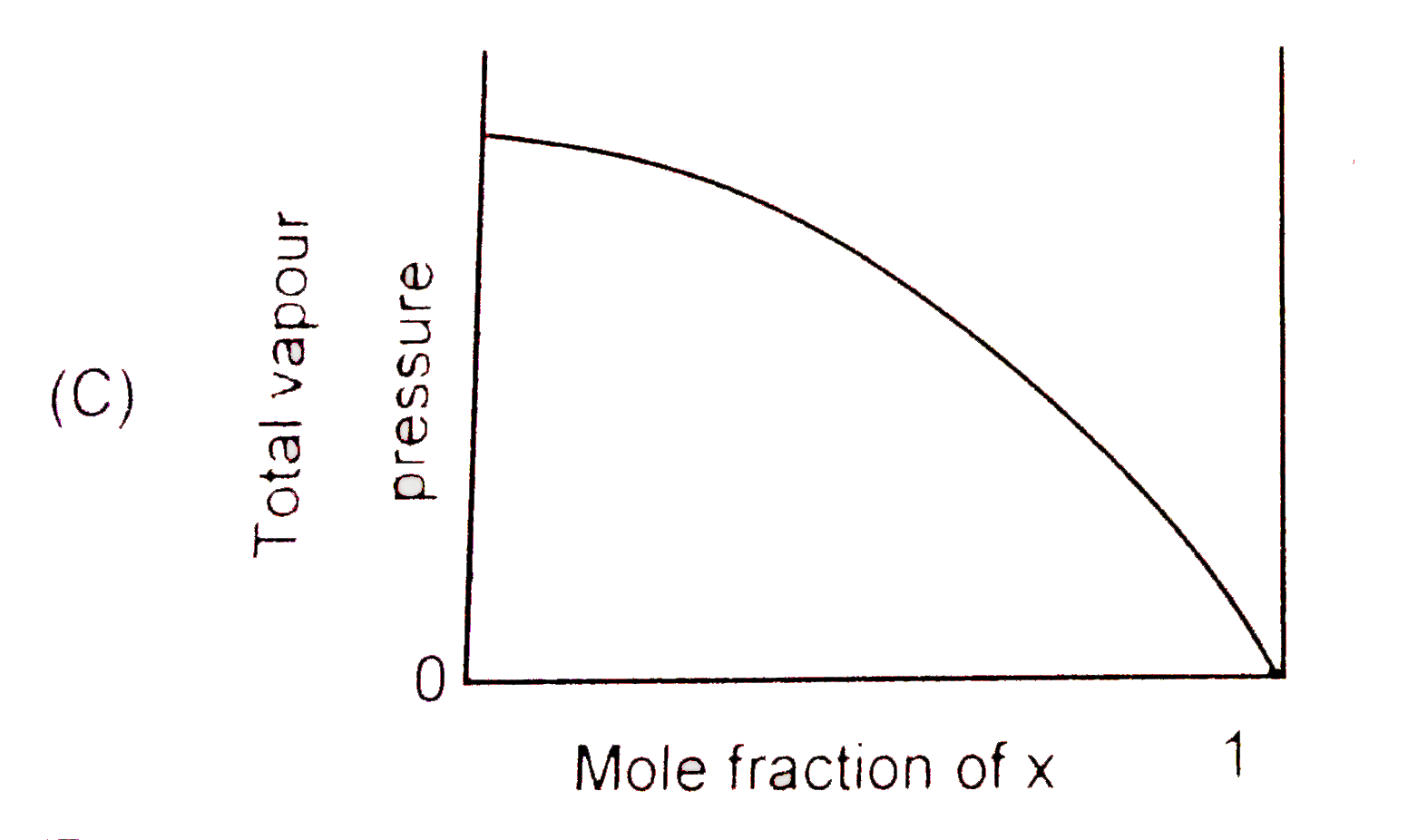Using Raoult's law explain how the total vapour pressure over the solution is related to mole fraction of components in the following solutions.
(ii) NaCl(s)andH2O(l)
To explain how the total vapor pressure over a solution of NaCl and H₂O is related to the mole fraction of its components using Raoult's law, we can follow these steps:
Step 1: Understand Raoult's Law
Raoult's law states that the partial vapor pressure of each component in a solution is directly proportional to its mole fraction in the solution. Mathematically, it can be expressed as:
Pi=Xi⋅P0i
where:
- Pi is the partial vapor pressure of component i,
- Xi is the mole fraction of component i,
- P0i is the vapor pressure of the pure component i.
Step 2: Identify the Components
In the solution of NaCl (sodium chloride) and H₂O (water), we have:
- H₂O as the solvent (volatile component),
- NaCl as the solute (non-volatile component).
Step 3: Determine the Vapor Pressure of H₂O
Since NaCl is a non-volatile solute, it does not contribute to the vapor pressure of the solution. Therefore, the total vapor pressure of the solution will depend solely on the vapor pressure of H₂O. According to Raoult's law, the partial vapor pressure of H₂O can be calculated as:
PH2O=XH2O⋅P0H2O
where:
- XH2O is the mole fraction of water in the solution,
- P0H2O is the vapor pressure of pure water.
Step 4: Calculate the Total Vapor Pressure
The total vapor pressure Ptotal of the solution is equal to the partial vapor pressure of H₂O, since NaCl does not contribute to the vapor pressure:
Ptotal=PH2O=XH2O⋅P0H2O
Step 5: Relate Mole Fraction to Total Vapor Pressure
As the mole fraction of H₂O increases (i.e., as more water is present in the solution), the total vapor pressure of the solution increases. Conversely, if the mole fraction of H₂O decreases (i.e., if more NaCl is added), the total vapor pressure of the solution decreases.
Conclusion
In summary, the total vapor pressure of the solution of NaCl and H₂O is directly related to the mole fraction of H₂O, as described by Raoult's law. The presence of NaCl reduces the mole fraction of H₂O, thereby lowering the total vapor pressure of the solution.
---
Raoult's law states that the partial vapor pressure of each component in a solution is directly proportional to its mole fraction in the solution. Mathematically, it can be expressed as:
Pi=Xi⋅P0i
where:
- Pi is the partial vapor pressure of component i,
- Xi is the mole fraction of component i,
- P0i is the vapor pressure of the pure component i.
In the solution of NaCl (sodium chloride) and H₂O (water), we have:
- H₂O as the solvent (volatile component),
- NaCl as the solute (non-volatile component).
Since NaCl is a non-volatile solute, it does not contribute to the vapor pressure of the solution. Therefore, the total vapor pressure of the solution will depend solely on the vapor pressure of H₂O. According to Raoult's law, the partial vapor pressure of H₂O can be calculated as:
PH2O=XH2O⋅P0H2O
where:
- XH2O is the mole fraction of water in the solution,
- P0H2O is the vapor pressure of pure water.
The total vapor pressure Ptotal of the solution is equal to the partial vapor pressure of H₂O, since NaCl does not contribute to the vapor pressure:
Ptotal=PH2O=XH2O⋅P0H2O
As the mole fraction of H₂O increases (i.e., as more water is present in the solution), the total vapor pressure of the solution increases. Conversely, if the mole fraction of H₂O decreases (i.e., if more NaCl is added), the total vapor pressure of the solution decreases.
In summary, the total vapor pressure of the solution of NaCl and H₂O is directly related to the mole fraction of H₂O, as described by Raoult's law. The presence of NaCl reduces the mole fraction of H₂O, thereby lowering the total vapor pressure of the solution.
Topper's Solved these Questions
- SOLUTIONSBook:PRADEEPChapter:SOLUTIONSExercise:ADDITIONAL QUESTIONS (VERY SHORT ANSWER QUESTIONS)
Explore 41 Videos
- SOLUTIONSBook:PRADEEPChapter:SOLUTIONSExercise:ADDITIONAL QUESTIONS (SHORT ANSWER QUESTIONS)
Explore 60 Videos
- SOLUTIONSBook:PRADEEPChapter:SOLUTIONSExercise:NCERT (EXEMPLAR PROBLEMS WITH ANSWERS, HINTS AND SOLUTIONS) (ASSERTION AND REASON TYPE QUESTIONS)
Explore 4 Videos
- REDOX REACTIONS Book:PRADEEPChapter:REDOX REACTIONS Exercise:Assertion reason type question
Explore 16 Videos
- SOME BASIC CONCEPTS OF CHEMISTRYBook:PRADEEPChapter:SOME BASIC CONCEPTS OF CHEMISTRYExercise:Competition (FOCUS) JEE (Main and Advanced)/Medical Entrance SPECIAL (VIII. Assertion-Reason Type Questions)(Type II)
Explore 13 Videos
Similar Questions
Using Raoult's law explain how the total vapour pressure over the solution is related to mole fraction of components in the following solutions.
(i) CHCl3(l)andCH2Cl2(l)
View SolutionUsing Raoult's law, explain how the total vapour pressure over the solution is related to mole fraction of components in the following solutions : (i) CHCl3(l) and CH2Cl2(l) (ii) NaCl(s) and H2O(l)
View Solution
Knowledge Check
According to Raoult's law the relative lowering of vapour pressure for a solution is equal to
AMole fraction of soluteBMole fraction of solventCMoles of soluteDMoles of solventIf Raoult's law is obeyed, the vapour pressure of the solvent in a solution is directly proportional to
AThe mole fraction of the solvent.BThe mole fraction of the solute.CThe mole fraction of the solvent and solute.DThe volume of the solution.The plot of total vapour pressure as a function of mole fraction of the component of an ideal solution formed by mixing liquids X and Y is
A B
B C
C D
D
Using Raoult's Law explain how the total vapour pressure over the solution is related to mole fraction of components in the following solution.
CHCl3 (l)andCH2Cl2(l) (b)NaCl(s)andH2O(l)
View SolutionRelative loweringof vapour pressure of a dilute solution is 0.2. What is the mole fraction of non-volatile solute ?
View SolutionAn ideal solution of two liquids is a solution in which each component obeys Raoult's which states that the vapour pressure of any component in the solution depends on the mole fraction of that component in the solution and the vapour pressure of that component in the pure state. However, there are many solution which do not obey Raoult's law. In other words, they show deviations from ideal behaviour which may be positive or negative. However, in either case, corresponding to a particular composition, they form a constant boiling mixtures called azeotropes.
Which of the following mixture do you expect will not show positive deviation from Raoult's law ?
View SolutionAn ideal solution of two liquids is a solution in which each component obeys Raoult's which states that the vapour pressure of any component in the solution depends on the mole fraction of that component in the solution and the vapour pressure of that component in the pure state. However, there are many solution which do not obey Raoult's law. In other words, they show deviations from ideal behaviour which may be positive or negative. However, in either case, corresponding to a particular composition, they form a constant boiling mixtures called azeotropes.
Which of the following mixture do you expect will not show positive deviation from Raoult's law ?
View SolutionAn ideal solution of two liquids is a solution in which each component obeys Raoult's which states that the vapour pressure of any component in the solution depends on the mole fraction of that component in the solution and the vapour pressure of that component in the pure state. However, there are many solution which do not obey Raoult's law. In other words, they show deviations from ideal behaviour which may be positive or negative. However, in either case, corresponding to a particular composition, they form a constant boiling mixtures called azeotropes.
A solution has a 1:4 mole ratio of pentane to hexane. The vapour presssures of the pure hydrocarbons at 20∘C are 440 mm of Hg for pentane and 120 mm of Hg for hexane. The mole fraction at pentane in the vapour phase would be
View Solution
